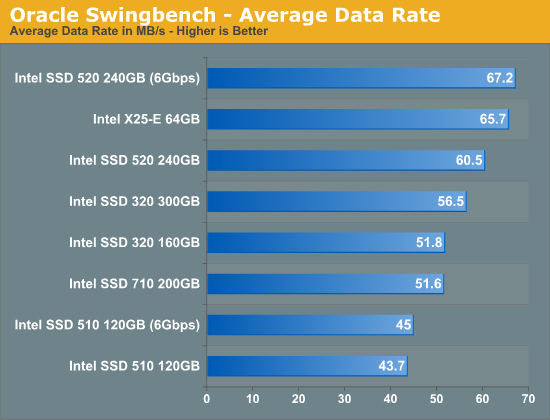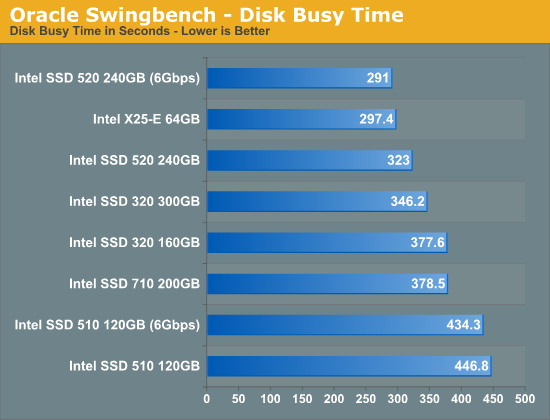A Look at Enterprise Performance of Intel SSDs
by Anand Lal Shimpi on February 8, 2012 6:36 PM EST- Posted in
- Storage
- IT Computing
- SSDs
- Intel
Enterprise Storage Bench - Oracle Swingbench
We begin with a popular benchmark from our server reviews: the Oracle Swingbench. This is a pretty typical OLTP workload that focuses on servers with a light to medium workload of 100 - 150 concurrent users. The database size is fairly small at 10GB, however the workload is absolutely brutal.
Swingbench consists of over 1.28 million read IOs and 3.55 million writes. The read/write GB ratio is nearly 1:1 (bigger reads than writes). Parallelism in this workload comes through aggregating IOs as 88% of the operations in this benchmark are 8KB or smaller. This test is actually something we use in our CPU reviews so its queue depth averages only 1.33. We will be following up with a version that features a much higher queue depth in the future.

SLC NAND offers great write latency and we see a definite advantage to the older drive here in our Swingbench test. Only a 6Gbps SSD 520 is able to deliver better performance, everything else trails the 3+ year old drive. Note that the Marvell based Intel SSD 510, even on a 6Gbps controller, is the slowest drive in Intel's lineup. From a write amplification perspective, Marvell's controller has always been significantly behind Intel's own creations so the drop in performance isn't surprising. The 710 actually delivers performance that's lower than the 320, but you do get much better endurance out of the 710.


While throughput isn't much better on the 6Gbps Intel SSD 520, average service time is tangibly lower. There's clearly a benefit to higher bandwidth IO interfaces in the enterprise space, which is a big reason we're seeing a tremendous push for PCIe based SSDs. The 710 does well here but not nearly as well as the X25-E which continues to behave like a modern SSD thanks to its SLC NAND.










55 Comments
View All Comments
krazyderek - Thursday, February 9, 2012 - link
i've been thinking about recycling some agility 2's into a raid array on a server, and this article gives a great blue print on the intel side of things! thank you!neotiger - Thursday, February 9, 2012 - link
It's important to note that most of the SSDs you tested are not suitable for "enterprise" use because they are not crash-safe.X25-E, 510, 520 - none of them come with capacitors. That means in the event of a crash or power outage your data will be lost or corrupted (most likely both). They are not suited for enterprise use.
Per Hansson - Sunday, February 12, 2012 - link
Hi Anand,Any interest in testing Adaptecs Hybrid RAID?
It claims to offer good speed on a RAID-1 setup with a normal HDD together with a SSD.
Something that on a normal controller would limit the SSD to the write speed of the HDD...
http://ask.adaptec.com/scripts/adaptec_tic.cfg/php...
Also will you be including any more SLC drives in your tests?
Like the Micron RealSSD P300
http://www.micron.com/products/solid-state-storage...
I love that you are finally starting to do enterprise tests :)
Regards,
Per Hansson
silversurferer - Saturday, February 18, 2012 - link
Hi,Fabulous article - very well written!
Just digging in on SSD since im having huge problem with my mailserver as the accounts and files grow in numbers and weight.
It seems that SSD is made for this, if im not mistaking. Witch SSD disk would be suited for this and what kind of setup is recommended? Take gladely any pointers in this subject.
Thx.
enealDC - Monday, February 20, 2012 - link
Don't normally post, but I wanted to say great read!